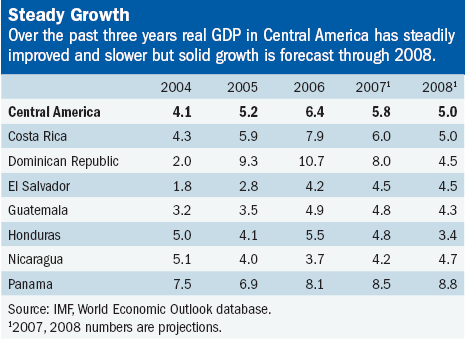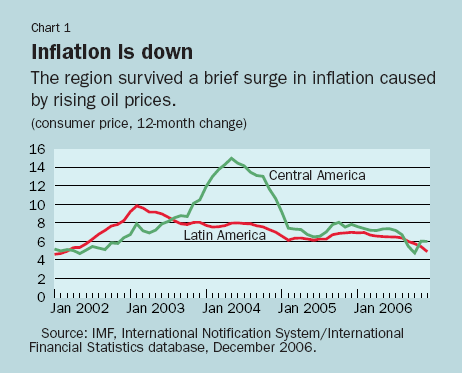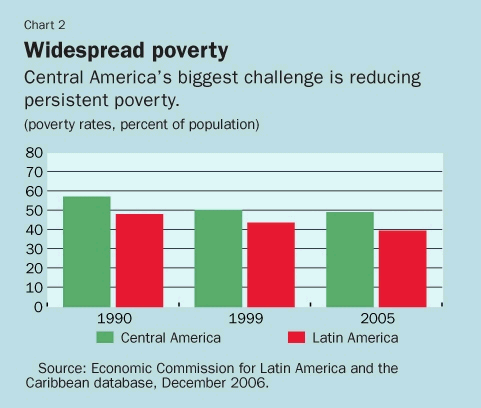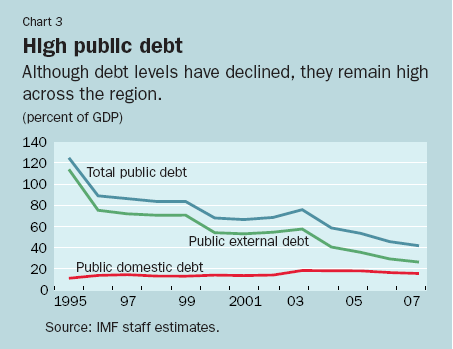
Typical street scene in Santa Ana, El Salvador. (Photo: iStock)
IMF Survey: Central America Aims for Stronger Growth
August 2, 2007
- Central America has made good economic progress in recent years
- Despite economic growth, poverty remains persistent, widespread
- Region must reduce vulnerability to shocks, boost growth potential
Times are better in Central America.

Ox cart in Costa Rica—one of only 3 Central American countries with per capita GDP higher than 30 years ago (photo: Philip Coblentz/PictureArts)
REFORMS TO REDUCE POVERTY
After years of political and economic turmoil in many countries, the region has made important economic advances against a backdrop of both improved political stability and favorable global economic conditions. Real GDP has recovered (see table), inflation has remained under control despite the upsurge in oil prices (see Chart 1), and exports have been strong.

Still, poverty is persistent and widespread, and Central American countries remain vulnerable to economic events outside their control. Thus, as emphasized by ministers of finance, central bank governors, and financial superintendents in a communiqué issued at the conclusion of a conference on Central America, Panama, and the Dominican Republic, the region must take "advantage of good times to tackle the daunting tasks of entrenching stronger growth, reducing still-high levels of poverty, and decreasing vulnerabilities against adverse shocks."

The sixth annual regional conference—held in San José, Costa Rica on June 29-30—coincided with publication of an IMF Occasional Paper, "Economic Growth and Integration in Central America." The paper analyzes various issues closely related to achieving those reform objectives.
Fighting high poverty levels
A central objective of reforms in the region is to reduce poverty, Central America's biggest challenge (see Chart 2). To lift people out of poverty and significantly raise living standards, addressing issues of economic growth is paramount.
Average growth rates of the past decade have fallen short of the records achieved in the 1960s and 1970s, and the region's growth performance has lagged significantly behind that of the more dynamic emerging market economies in the world, especially those in Asia. As a result, only three countries in the region, Costa Rica, Panama, and the Dominican Republic, have succeeded in raising GDP per capita levels above those observed in the late 1970s; and only in Costa Rica is the poverty level substantially lower now than three decades earlier.

Improving the growth performance in Central America will depend to a large degree on the countries' abilities to implement productivity-enhancing reforms. During 1960-2005, increases in output per worker reflected almost exclusively increased investment in capital equipment rather than productivity growth; and variations in growth within subperiods and across countries were closely associated with differences in productivity growth.
Stronger institutions
How then to raise productivity in Central America? The extensive literature on sources of growth in developing countries points to, among other findings, the benefits of strengthening institutions.
Indeed, a simulation suggests that bringing overall institutional quality—such as government effectiveness, control of corruption, political instability and violence, regulatory burden, voice and accountability, and the rule of law—up to Chile's level could raise growth by half a percentage point a year in Central American countries with relatively strong institutions (Costa Rica) and by 3 percentage points or more a year in countries with relatively weak institutions (Guatemala, Honduras, and Nicaragua).
A concerted effort to improve institutions and the business environment in Central America is also paramount to ensuring that the Central American Free Trade Agreement with the United States and a potential Association Agreement with the European Union will lead to the expected productivity improvements and tangible benefits for all.
Fiscal sustainability
Macroeconomic policies have strengthened, but high debt levels and future contingent claims, especially pension benefits, still leave public finances vulnerable. The authorities must take further steps to reduce debt levels, which, with the exception of Guatemala's, remain high, averaging 47 percent of GDP at the end of 2006 (see Chart 3). In parallel, they need to raise tax revenue further to meet pressing social and investment needs in a fiscally responsible manner.

Putting Central America's pension systems on a sound long-term footing is a key component of this strategy. Although Central America has more favorable demographics than countries with low or even declining birth rates, its population will age substantially and the ratio of the working-age population to the elderly will, for example, fall from about eight today to less than three in 2050, making the systems unsustainable.
Political support
Although there is no one-size-fits-all solution, sustainability requires some combination of increased contribution rates, higher retirement ages, and lower benefits in most countries. The success of implementing pension reforms in Central America will depend not only on the design of the reforms themselves, but also on the authorities' ability to mobilize the necessary political support.
Another key element in reducing vulnerability is moving toward "safer" debt structures, because sustainability is a function not only of the level of debt but also of its structure. Currency denomination, maturity composition, capital structure, and solvency play important roles in determining the possibility of a crisis, and often public sector balance sheets exhibit significant mismatches along those dimensions.
An analysis of Central America's sovereign debt structures reveals that, on average, the region has a lower share of short-term debt than the rest of Latin America, but a higher share of foreign currency debt. In line with broader developments in emerging markets, more recently, Central America has been able reduce its foreign currency exposure and to lengthen its maturity structure modestly. Such efforts are a step in the right direction and should be continued.
Strengthening monetary policy
Central American countries have succeeded in reducing inflation, but bringing it all the way down to the level of its trading partners will continue to pose a challenge. In pursuit of this objective, they have made substantial progress in strengthening the institutional underpinnings for formulating and executing monetary policy.
New central bank legislation has given the monetary authorities enhanced autonomy, and, as a result, the mandate of central banks is more clearly focused on preserving price stability. Central banks have also benefited from increased de jure political autonomy. Direct political intervention in central bank decisions and monetary financing of fiscal deficits has been curtailed.
Central bank credibility
Nevertheless, monetary policy frameworks have some remaining shortcomings. Efforts to maintain price stability while preserving the external value of the domestic currency raises concerns about objectives, causes policy conflicts (for example, in the case of strong capital inflows), and undermines the credibility of central banks.
There is still a potentially strong link between the political business cycle and monetary policy decisions because the executive branch continues to have substantial leeway to remove central bank governors and other members of the board of central bank directors.
Furthermore, central banks generally continue to lack financial autonomy because there are often no legal provisions to protect the integrity of central bank capital, which in turn substantially undermines the effectiveness and credibility of monetary policy. It will be important to make progress on these issues in the coming years.
Development of financial systems
The region's financial sector is dominated by banks, and—with the exception of Panama, which has a bank-asset-to-GDP ratio of 250 percent—there is substantial room for further development. Capital markets are underdeveloped across countries and the number of equity and corporate bond listings are generally in the single digits. Institutional investors ,such as pension funds, mutual funds, and insurance companies, intermediate only a small share of national savings.
Whereas there is no simple solution to developing private equity and corporate bond markets, there is substantial room to develop public debt markets, especially through institutional and operational improvements. For example, to aid the establishment of liquid public debt markets and a unified sovereign yield curve, the quasi-fiscal debts of central banks need to be transferred to the government, thus dealing directly with the problem of dual sovereign debt issuers.
Debt management strategy
Also, the region has a large stock of nonstandard and nontradable debt, which should be restructured. In most countries, it will also be important to develop and implement a medium-term debt management strategy and improve the technical capacity of debt management units.
In that respect, Costa Rica, El Salvador, and Panama have made some improvements over the last couple of years. Deeper and more liquid public debt markets, in turn, would allow the authorities in countries with their own currency to conduct monetary policy more effectively.
As IMF Deputy Managing Director Murilo Portugal emphasized in his recent speech at the Sixth Annual Regional Conference on Central America, Panama, and the Dominican Republic, now is the time for Central America to reform, for countries to take advantage of the benign global environment. After all, "it is in the sunny days that we should fix the roof of the house."
This article is based on Occasional Paper No. 257, Economic Growth and Integration in Central America, edited by Dominique Desruelle and Alfred Schipke. Copies are available in English and Spanish for $30.00 each ($28.00 for full-time faculty members and students at universities and colleges) online or from IMF Publication Services, 700 19th St., N.W., Washington, D.C. 20431.


